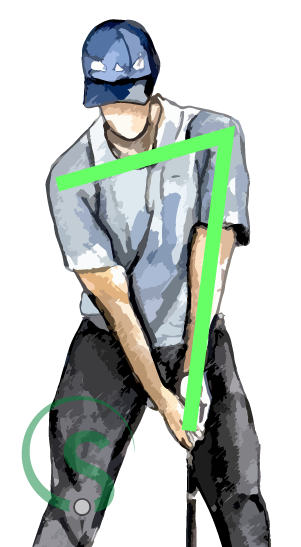The Fourth Power Accumulator
This is the angle formed between the straight left arm and the shoulders.(1) Where the first power accumulator makes up one side of the triangle assembly (the distance between the hands and the right shoulder), the fourth accumulator is formed by the remaining two sides. This accumulator is at its “in line” condition when the upper left arm forms a straight line with the shoulders.(2)
The fourth power accumulator is responsible for moving the primary lever assembly by using the anti-clockwise rotation of the shoulders during the downstroke to push the left arm towards impact. The shoulders are known as a “dual agent” in this respect because they are not only a part of the power package, being one side of the triangle assembly, but they are also a part of the pivot.(3)
The fourth power accumulator is responsible for moving the primary lever assembly by using the anti-clockwise rotation of the shoulders during the downstroke to push the left arm towards impact. The shoulders are known as a “dual agent” in this respect because they are not only a part of the power package, being one side of the triangle assembly, but they are also a part of the pivot.(3)

Conversely, the fourth accumulator is most effective when maintaining its maximum “out of line” condition of the left arm across the body. Where the left arm touches the left side of your body (in most cases your chest) you’ll find the fourth power accumulator’s pressure point.(4) The turning of the shoulders forces your left side to push against the left arm. Once the left arm leaves the chest, the fourth pressure point no longer exists. The left arm / primary lever assembly must then rely on momentum or the first power accumulator to continue moving towards impact.
Creating the triangle assembly between them, the fourth and first accumulators work in unison. Decreasing the angle between the left arm and shoulders will also decrease the distance between the hands and right shoulder, and vice versa.(5) This being the case, you’d be forgiven for thinking the first and fourth accumulators only work as a pair, in that with one must be the other. This isn’t the case. Mr Kelly tells us in the preface to The Golfing Machine: “The golf stroke involves, mainly, two basic elements - the geometry of the circle and the physics of rotation.”
In layman’s terms, the geometry is what you see. It is the structure of the swing, the relationships between the many moving parts of your body and the golf club. When we watch a golf swing, we can observe which accumulators are accumulating. Quite often it appears to be all of them. However, this is to ignore the physics of the swing. In this context, the physics of the swing are the forces involved in making the body and the club move. So when we see during the downswing the left arm move away from the body and the right arm straightening, the geometry is obvious, but the physics not so. We can’t tell so easily if the left arm is moving away from the body because of momentum from the turning shoulders having pushed the arm away, or if it’s the right arm pushing the left arm away by extending. It looks to be both, but in reality it could be just the one.
Mr Kelley states: “It may appear that some of the accumulators omitted from some combinations are still actually present in the action. But their participation is negligible, incidental or minimal.”(6)
Creating the triangle assembly between them, the fourth and first accumulators work in unison. Decreasing the angle between the left arm and shoulders will also decrease the distance between the hands and right shoulder, and vice versa.(5) This being the case, you’d be forgiven for thinking the first and fourth accumulators only work as a pair, in that with one must be the other. This isn’t the case. Mr Kelly tells us in the preface to The Golfing Machine: “The golf stroke involves, mainly, two basic elements - the geometry of the circle and the physics of rotation.”
In layman’s terms, the geometry is what you see. It is the structure of the swing, the relationships between the many moving parts of your body and the golf club. When we watch a golf swing, we can observe which accumulators are accumulating. Quite often it appears to be all of them. However, this is to ignore the physics of the swing. In this context, the physics of the swing are the forces involved in making the body and the club move. So when we see during the downswing the left arm move away from the body and the right arm straightening, the geometry is obvious, but the physics not so. We can’t tell so easily if the left arm is moving away from the body because of momentum from the turning shoulders having pushed the arm away, or if it’s the right arm pushing the left arm away by extending. It looks to be both, but in reality it could be just the one.
Mr Kelley states: “It may appear that some of the accumulators omitted from some combinations are still actually present in the action. But their participation is negligible, incidental or minimal.”(6)
